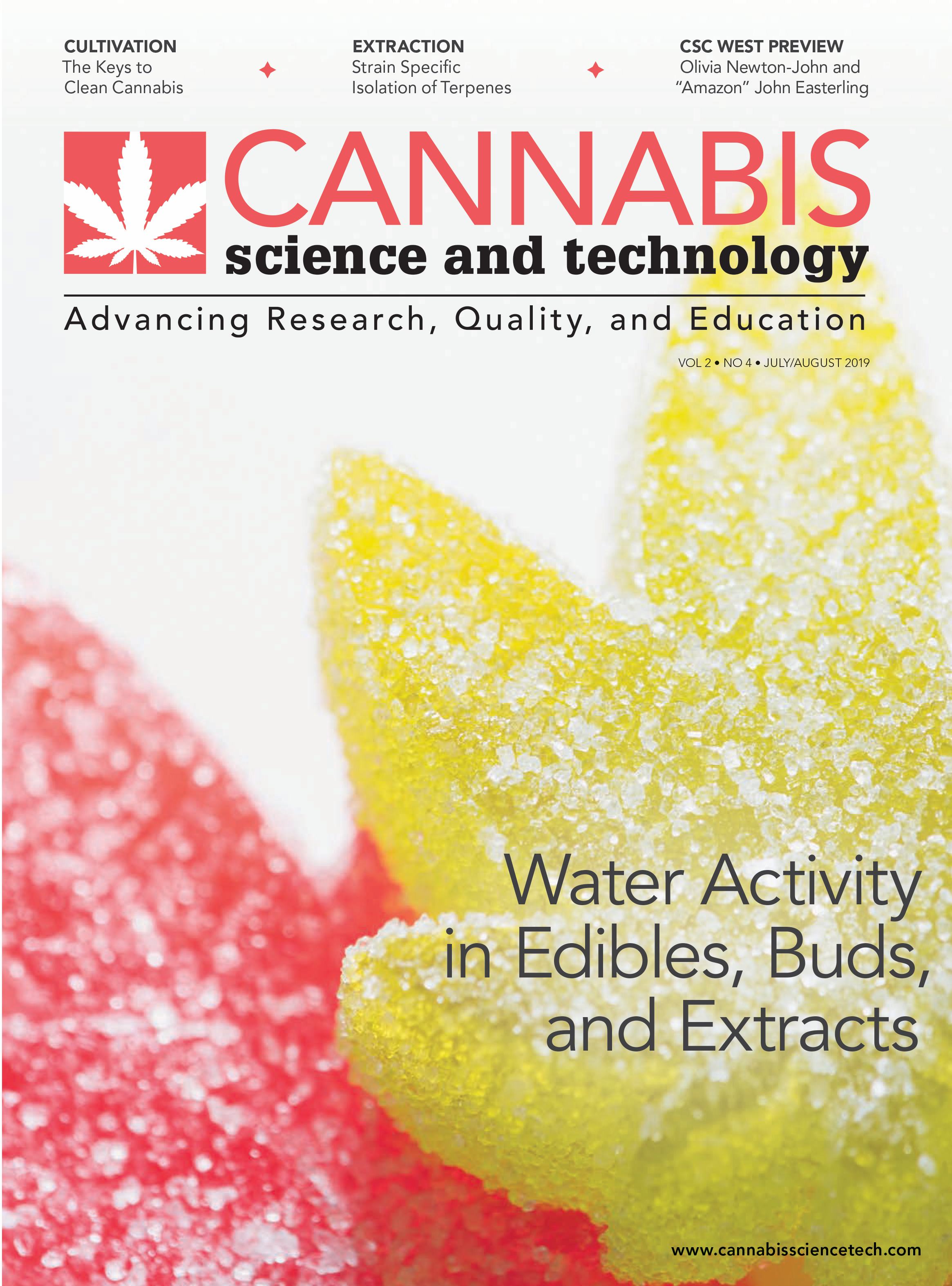Cannabis Is Medicine . . . Test It like Medicine
What changes need to be adopted in our industry to make the transition to the pharmaceutical industry testing paradigm?
Figure 1 (click to enlarge): A hypothetical manufacturing process for making aspirin tablets. To follow the pharmaceutical testing paradigm, tests must be performed on the raw materials, after each manufacturing step, and at the final product stage.

The purpose of this column is to make the case that cannabis is medicine, and thus the testing paradigm in use by the pharmaceutical industry needs to be adopted by the cannabis industry. I will introduce the pharmaceutical industry testing paradigm, contrast it with how things are currently done in the cannabis industry, and discuss the changes that need to be adopted in our industry to make the transition to what I believe is the correct testing paradigm.
There, I finally said it in the title of a column, “Cannabis is Medicine . . . Test it Like Medicine.” As I have stated in a previous column (1), I seriously considered making this the name of my column. I ultimately chose “Cannabis Analysis” because it is a broader topic, and I like that the words in the title rhyme.
As stated above, the purpose of this column is to make the case that cannabis is medicine, thus the testing paradigm in use by the pharmaceutical industry needs to be adopted by the cannabis industry. Here, I will introduce the pharmaceutical industry testing paradigm, contrast it with how things are currently done in the cannabis industry, and discuss the changes that need to be adopted in our industry to make the transition to what I believe is the correct testing paradigm.
The Pharmaceutical Industry Testing Paradigm
The pharmaceutical industry in the United States is regulated by the U.S. Food and Drug Administration (FDA). All prescription drugs must undergo rigorous chemical testing and clinical trials before being approved for use in humans. The FDA’s mission can be summarized in the phrase that all medicines need to be “safe and effective.” To achieve this, drug companies perform what I call “cradle-to-grave” testing. That is, they test every raw material that goes into a medicine, they test after each manufacturing step, and they test the final product before it goes out the door.
Figure 1 gives an idea of how this works. (See upper right for Figure 1, click to enlarge.) Imagine you work at a factory that makes aspirin tablets. All the ingredients for the tablets, including the active pharmaceutical ingredient (API), acetylsalicylic acid, and the excipients come in at the loading dock in barrels. To follow the pharmaceutical testing paradigm, representative samples of each material are collected (more on representative sampling here [2,3]) and then checked for identity and purity.
Assuming all the raw materials pass muster, they must next be mixed together in a blender as seen in Figure 1.
The material in the blender must be sampled and tested over time to see how well mixed it is. The blending must continue until the material is thoroughly mixed. The mixed material is then pressed into a tablet with a tableting press. The tablets must be sampled and tested to see if the right amount of API and excipients are present in the tablets. Lastly, representative samples of final tablet product are tested before a batch of aspirin bottles can go out the door. All tests are performed according to a standard operating procedure (SOP). No material can proceed onto the next step unless it meets a predetermined set of stringent criteria.
This level of testing is required by FDA regulations. However, it also makes good economic sense to perform cradle-to-grave testing. By testing each material before and after each manufacturing step, the manufacturing process can be controlled so that product can be made safely and reproducibly. Testing data can also be used to optimize manufacturing steps by maximizing output while minimizing costs. Lastly, by making safe and effective medicines the potential for causing damage to your customers with concomitant bad publicity, loss of business, and lawsuits will be avoided. Given these facts, a strict cradle-to-grave testing regimen makes sense even in the absence of federal regulations. Please note that all this testing is done in-house by the pharmaceutical company.
Cannabis is Medicine...
The FDA has finally acknowledged that the cannabinoid cannabidiol (CBD) has medicinal uses. Specifically, it is recommended to treat some types of epilepsy (4). Subsequently, CBD now appears to be everywhere. All manner of CBD concoctions are now available on the internet. Retail drug store chains are selling it nationwide (5), and there is even a hamburger chain adding CBD to their burgers (6).
Brian C. Smith

Are We Testing Cannabis like Medicine?
The short answer is no. In my career I have been able to observe the operation of numerous cannabis growers, extractors, processors, and cannabis analysis laboratories. What I see too often is that growers only test when their grow is over, thus they have no idea how changing water, light, and fertilizer will affect their crop. They also do not know the optimum time to harvest. I see extractors buying untested biomass, not knowing the cannabinoid content of the material and therefore probably paying the wrong price for it. I see the same extractors not testing every extract batch made in-house to correlate the extract with the quality of the biomass, and thus have no clue as to how to optimize their process. I see processors who buy untested extract who then winterize, decarboxylate, distill, and then formulate products without doing any testing. How can you make a consistently safe and effective medicine without testing after each manufacturing step? How can you get your label claims right and be compliant if you don’t test the product yourself before it goes out to a third-party laboratory?
Compliance Testing Versus In-House Testing
In summary, too often in the cannabis industry testing is only done at the end of the process where the product is closest to the consumer and regulations require compliance testing. The danger in this is mislabelled product and compliance testing failures. In California last summer, more than 1200 product batches failed state compliance testing because of mislabelled product (7). This occurred because cannabis businesses assumed test results on one batch apply to other batches. This may be true for a well characterized and controlled process supported with extensive quality control testing. However, in the absence of this testing batches are not reproducible, leading to incorrect labels. These failures are expensive. The questioned batches must either be retested, remediated, or scrapped.
The answer to this problem is that cannabis businesses need to adopt the cradle-to-grave testing paradigm and perform more in-house testing and do it better. They need to have the appropriate instrumentation and personnel in place to test raw materials, test after every manufacturing step, and test the final product itself before it goes out for compliance testing to ensure label claims are correct and to avoid compliance test failures.
In my observation, not enough cannabis companies are performing in-house testing. I blame this in part on government regulators who have focused solely on compliance testing and have not required cannabis businesses to perform in-house testing. Lastly, I blame us in the cannabis industry for taking the easy way out and only testing when required by regulations, rather than doing what makes economic and ethical sense and adopting the cradle-to-grave testing paradigm.
We might not like to think of it this way, but cannabis processors are de facto pharmaceutical manufacturers. In the pharmaceutical industry there is a testing laboratory, trained personnel, process engineers, quality control people, and regulatory compliance officers to make sure the product is tested and manufactured according to accepted standards. Where are these people in the cannabis industry? The answer is they are too few and far between. I see people with no technical background starting cannabis medicine businesses, hiring people with little or no appropriate technical background to supervise and run their chemical processing operations, do little or no in-house testing, and then stumble forward inefficiently making irreproducible product. This is a threat to the health and safety of patients, and to the bottom line of cannabis companies.
The solution to this problem is for the cannabis industry is to do more in-house testing. There exist spectroscopic and chromatographic instruments for testing plant material, extracts, oils, distillates, and final products (many of which are advertised in this magazine). Some of these are fast, accurate, and easy to use and cost little compared to the cost of the capital equipment needed to start a grow or processing facility, or to the cost of a lawsuit from a patient injured from an incorrectly made medicine.
Conclusion
The solution here is that cannabis companies need to invest in the equipment and personnel to have a robust in-house quality control and testing program. Either we need to do this on our own, or regulators need to step up and force the industry to do this. If our goal as an industry is to achieve nationwide legalization of cannabis, we must prove to the American public that we can make safe and effective medicines. Until the strict cradle-to-grave testing paradigm is adopted by the industry that will not happen, and our long-cherished goal of universal legalization will not be met.
References:
- B.C. Smith, Cannabis Science and Technology2(3), 10–14 (2019).
- B.C. Smith, Cannabis Science and Technology2(1), 14–19 (2019).
- P. Atkins, Cannabis Science and Technology2(2), 26–34 (2019).
- https://www.fda.gov/news-events/press-announcements/fda-approves-first-drug-comprised-active-ingredient-derived-marijuana-treat-rare-severe-forms.
- https://www.cnbc.com/2019/03/27/walgreens-to-sell-cbd-products-in-some-stores.html.
- https://www.washingtonpost.com/news/voraciously/wp/2019/04/17/carls-jr-is-rolling-out-a-cbd-burger-but-dont-get-your-hopes-too-high/?noredirect=on&utm_term=.4920aef53386.
- https://mjbizdaily.com/nearly-a-fifth-of-california-marijuana-products-failing-testing-standards/.
About the Columnist
Brian C. Smith, PhD, is Founder, CEO and Chief Technical Officer of Big Sur Scientific in Capitola, California. Dr. Smith has more than 40 years of experience as an industrial analytical chemist having worked for such commpanies as Xeros, IBM, Waters Associates, and Princeton Instruments. For 20 years he ran Spectros Associates, an analytical chemistry training and consulting firm where he improved their chemical analyses. Dr. Smith has written three books on infrared spectroscopy, and earned a PhD in physical chemistry from Dartmouth College.
How to Cite This Article
B.C. Smith, Cannabis Science and Technology 2(4), 12–14 (2019).

New York OCM Launches New Higher Education Campaign Aimed to Strengthen Cannabis Education
April 22nd 2025New York OCM announces their new “Higher Education” statewide campaign which plans to provide cannabis users in the state with educational cannabis materials to help them navigate the marketplace.
Best of the Week: April 11 – April 17, 2025
April 18th 2025Here, we bring you our top four recent articles covering standards in the cannabis industry, a cannabis for sleep survey, a new research and resource center at the University of Mississippi, and in-person information sessions from Metrc.